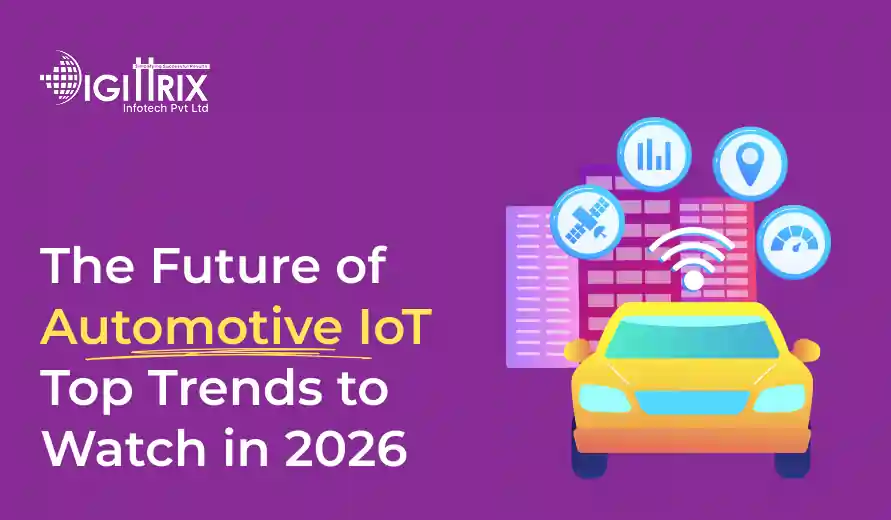By 2026, more than 75% of new vehicles are expected to be IoT-enabled, enhancing safety, connectivity, predictive maintenance, and overall driving efficiency in global automotive markets.
Highlights
An enthusiastic developer and skilled business management expert with over a decade of experience in the field

The automotive industry is changing quickly. The automotive industry is changing quickly, with the Internet of Things (IoT) playing a major role in this shift. IoT links vehicles, infrastructure, and drivers, making cars smarter, safer, and more efficient. By 2026, IoT integration in vehicles is expected to significantly improve. This article examines the trends shaping the future of automotive IoT and what they mean for businesses, drivers, and technology innovators.
Explore how AI is transforming IoT app development from concept to market-ready solutions in Digittrix’s latest blog post. Gain insights into turning innovative ideas into functional applications. Read the full article here.
Automotive IoT refers to a network of connected devices within and around vehicles that collect and transmit data. These devices include sensors, cameras, GPS units, onboard computers, and cloud platforms. The aim is to enhance vehicle performance, reduce accidents, improve fuel efficiency, and provide better services for users.
IoT is no longer limited to luxury or electric vehicles; it is now common in mainstream cars, fleet management systems, and public transit. The demand for smarter vehicles has also created opportunities for companies offering IoT app development solutions to build applications that make vehicles more intelligent and user-friendly.
Data plays a vital role in automotive IoT. Vehicles generate information every second, including engine performance, tire pressure, driving habits, and location data. Analyzing this data helps manufacturers, fleet operators, and drivers make more informed decisions.
By 2026, connected vehicles are expected to gather data more effectively. Data will come not only from individual cars but also from surrounding infrastructure like traffic lights, toll booths, and weather sensors. This growth will necessitate specialized IoT mobile app solutions to manage, visualize, and utilize data efficiently for drivers and automotive companies.
One of the most exciting advances in automotive IoT is Vehicle-to-Everything (V2X) communication. This technology allows vehicles to communicate with each other, traffic systems, and pedestrians to prevent accidents and improve traffic flow.
V2X employs various communication methods, including dedicated short-range communication (DSRC) and cellular networks. By 2026, wider adoption of V2X technologies is expected in both private and public transportation. Companies offering custom app development services can create apps that process V2X data for route optimization, vehicle safety alerts, and traffic management systems.
The shift toward electric vehicles (EVs) is a key driver influencing automotive IoT trends. EVs depend significantly on connected systems for battery management, charging station info, and performance tracking.
IoT integration allows EV owners to monitor battery health, control charging remotely, and locate nearby charging stations through mobile apps. IoT app development companies will see growing demand for apps tailored to these needs, helping EV owners manage their vehicles more efficiently.
Predictive maintenance has become a standard feature in modern vehicles. IoT sensors allow cars to detect problems early, lowering repair costs and minimizing downtime.
For example, sensors can monitor engine temperature, brake performance, and fluid levels. When abnormal patterns are detected, the system can notify drivers through a mobile app development services platform or a dedicated mobile app. By 2026, predictive maintenance will extend beyond individual vehicles, supporting fleet management and public transportation networks.
Traffic congestion is a major problem in cities, and IoT offers a solution with smart traffic management. By collecting data from vehicles, roadside sensors, and traffic cameras, urban areas can decrease congestion, optimize signal timings, and improve road safety.
Apps that incorporate traffic data can notify drivers about real-time traffic conditions, suggest alternative routes, or help plan travel times more efficiently. On-demand app development companies are increasingly building platforms that combine these features with navigation, parking assistance, and emergency alerts.
Automotive IoT is also improving the passenger experience. Connected cars now offer advanced infotainment systems that include streaming services, navigation, voice assistants, and personalized settings.
These systems rely on continuous data exchange between the car, the cloud, and user devices. IoT app developers are creating applications that allow passengers to control media, adjust vehicle settings, and access local services while on the move. By 2026, infotainment systems will become more interactive, offering smarter ways to keep passengers comfortable and entertained.
Self-driving cars are now more than just prototypes. Autonomous vehicles (AVs) use IoT technologies to detect their surroundings, make decisions, and navigate safely. IoT sensors like LiDAR, radar, and cameras work with AI algorithms to ensure safe driving.
Although fully autonomous vehicles may still be limited in some areas, 2026 is expected to see increased testing and deployment in controlled environments and city zones. Companies that provide custom app development can build companion apps for AVs that feature route planning, remote monitoring, and vehicle diagnostics.
Automotive IoT is becoming more essential for smart city initiatives. Connected vehicles can interact with city infrastructure to improve mobility, reduce energy consumption, and lower pollution.
For example, IoT-enabled cars can receive real-time updates about traffic jams, road hazards, and public transportation schedules. Apps developed by an IoT app development company can collect this information, helping drivers and city planners make better decisions. Connecting with smart city systems will also enhance emergency response and public safety.
As connectivity increases, the risk of cyberattacks also rises. Automotive IoT systems must safeguard sensitive data like personal information, payment details, and vehicle controls systems.
By 2026, cybersecurity will improve, including encryption, authentication protocols, and safe cloud storage. Businesses providing mobile app development must prioritize security when designing automotive IoT apps, ensuring users trust the technology without risking privacy.
Another emerging trend is personalization. IoT allows vehicles to adjust settings according to the driver’s preferences. This includes seat position, climate control, lighting, and even preferred routes.
Applications created by teams can store user profiles and deliver personalized recommendations for fuel stations, service centers, and nearby amenities. As consumers seek greater convenience, automotive IoT apps will aim to provide a more tailored driving experience.
Remote vehicle control is becoming more popular, especially in commercial transportation. IoT apps allow fleet managers to oversee vehicles, monitor fuel usage, schedule maintenance, and ensure driver safety.
For personal use, owners can remotely lock and unlock vehicles, start engines, or check the vehicle’s location. IoT app development companies can provide platforms supporting these features for both individual owners and large fleets.
AI and machine learning enhance automotive IoT capabilities. Connected vehicles generate and analyze large amounts of data, making predictive analytics, route optimization, and autonomous decision-making possible.
Apps developed through custom app development can leverage machine learning to recognize patterns in driving behavior, forecast maintenance needs, and even recommend safer routes. This integration ensures that vehicles not only gather data but also use it intelligently to enhance efficiency and safety.
IoT also supports environmental sustainability. Connected vehicles can monitor emissions, fuel efficiency, and energy use. Governments and regulatory agencies are increasingly encouraging the adoption of IoT in vehicles to reduce carbon footprints.
Applications created by an IoT app development company can help both individual drivers and businesses track their environmental impact, promote eco-friendly driving habits, and locate charging stations for electric vehicles. Sustainability-focused IoT apps are expected to become more common in 2026, supporting greener urban mobility.
Modern vehicles now receive software updates remotely through IoT connectivity. Over-the-air (OTA) updates allow manufacturers to fix bugs, improve features, and add new functions without a service visit.
Mobile app development services can integrate OTA management into companion apps, enabling users to control updates and notifications. This trend reduces maintenance costs and ensures vehicles stay current with the latest technology.
Despite its potential, automotive IoT faces several challenges:
Tackling these challenges is essential for the widespread adoption of IoT in vehicles. Companies providing on-demand app development solutions can help bridge these gaps by creating apps that address connectivity issues, ensure secure data transfer, and effectively integrate multiple IoT devices.
Curious about the future of IoT? Explore Digittrix’s insights into the top IoT trends shaping 2025 and beyond!
The future of automotive IoT in 2026 appears promising, emphasizing connected vehicles, smart traffic systems, predictive maintenance, and better passenger experiences. Electric and autonomous vehicles will be central to developing the market, while AI and machine learning will improve decision-making and operational efficiency.
As automotive IoT expands, businesses and app developers must prioritize security, customization, and user-friendly mobile app design. IoT app development solutions will be essential in making vehicles, fleets, and cities operate smarter.
By considering these trends and technologies, the automotive industry can prepare for a future where vehicles are more than just transportation; they are connected, responsive, and interactive platforms that enhance the driving and passenger experience.
By 2026, IoT will be transforming the automotive industry. Creating an automotive IoT app allows businesses to connect vehicles, manage real-time data, and provide smarter solutions for drivers and fleets.
At Digittrix, with over 14 years of experience, we focus on creating IoT mobile apps and automotive solutions that are secure, scalable, and easy to use. From connected car apps to vehicle monitoring and smart traffic dashboards, our solutions provide real value.
Turn your automotive IoT idea into a working app. Contact us at +91 8727000867 or digittrix@gmail.com.

Do you need help in Mobile App development?




Join over 1500+ businesses we've already helped!
In 2026, automotive IoT will enable predictive maintenance, autonomous driving, electric vehicle monitoring, V2X communication, and smart traffic management, making vehicles safer and more connected.
IoT app development allows businesses and users to create applications that monitor vehicle health, provide real-time traffic updates, manage electric vehicle charging, and improve passenger experience.
Yes. IoT mobile apps enable remote vehicle monitoring, locking/unlocking, engine start, route tracking, and notifications, giving drivers better control over their cars.
Sensors in connected vehicles collect data on engine performance, tire pressure, and fluid levels. Mobile apps then alert drivers or fleet managers when maintenance is needed to prevent breakdowns

©2025Digittrix Infotech Private Limited , All rights reserved.